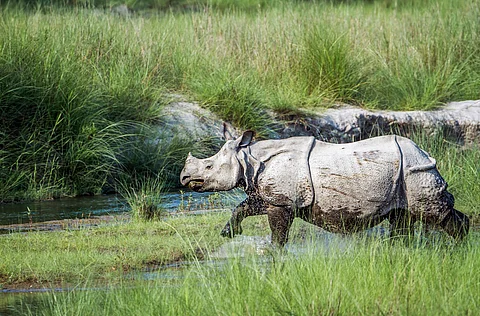Greater one-horned rhino numbers rise slightly, Javan ones plunge and black rhino numbers increase: State of the Rhino 2024
The State of the Rhino 2024 report reveals mixed trends in rhino populations worldwide.
Greater one-horned rhinos in India and Nepal have seen a slight increase, while Javan rhinos face a significant decline due to poaching.
Black rhino numbers in Africa have risen, but white rhinos in South Africa have decreased. Sumatran rhinos remain critically endangered, highlighting the ongoing poaching crisis.
The numbers of the greater one-horned rhinos (Rhinoceros unicornis) have risen slightly in India and Nepal, even as the numbers of Javan rhinos have dropped significantly while black rhino numbers in Africa have risen, according to the State of the Rhino 2024 report by the International Rhino Foundation (IRF).
The numbers of Sumatran rhinos have remained the same since the last estimates in 2022 and are considered to be ‘seriously imperiled’.
“White rhino numbers show various trends, with increases in all range states except South Africa, where poaching caused a slight decline in population,” a statement by the IRF noted.
There are 26,700 rhinos across the world.
“White rhinos have declined to 15,752 from 15,942, a drop of about 190 since the end of 2021 when numbers were last officially reported. Javan rhinos declined from an estimated 76 to approximately 50, due entirely to heavy poaching losses. The Sumatran rhino population remained the same at an estimated 34-47, while greater one-horned rhino numbers rose from 4,014 to 4,075. Black rhinos increased to 6,788 from the last count of 6,195. These numbers do not include rhinos in zoos,” the IRF statement added.
“The new report is a mixed bag for rhinos, indicating most rhinos are still dangerously threatened by poaching,” said Nina Fascione, executive director of the International Rhino Foundation (IRF). “To truly save rhinos, we need to stem the poaching crisis and improve biological management to bolster individual populations.”
Rhinos in South Asia
The report credited the trans-boundary management strategy implemented by India, Nepal and Bhutan as well as strict government protection and management for the rise in greater one-horned rhino numbers from fewer than 100 animals over the last century.
Rhino numbers, it added, had increased by about 20 per cent over the past decade.
“Though the greater one-horned rhino population is growing, the species is still classified as Vulnerable,” it added.
A significant threat to greater one-horned rhinos is poaching, which has caused local extinctions in various parts of its former range.
“Its full recovery depends not only on protecting rhinos where they have managed to survive but also reintroducing them to places from which they’ve disappeared,” said the report.
It added that another significant landscape level threat to greater one-horned rhinos is the prevalence of invasive species, which choke out native rhino food plants and limit the amount of habitat available.
“There is also some concern that greater one-horned rhinos could be one of the hardest hit by climate change, as stronger monsoon seasons and limited space and resources cause habitat disruption and increase the threat of human-wildlife conflict,” the report concluded.


